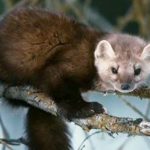Enhydra lutis
One of the heaviest members of the weasel family, the sea otter is also the second smallest marine mammal. Sea otters have the densest fur in the animal kingdom, ranging from 250,000 to a million hairs per square inch, which insulates them and maintains warmth. Unlike other marine mammals, the sea otter does not have a layer of blubber (fat) to help keep it warm.
Characteristics
The sea otter displays numerous adaptations to its marine environment. The nostrils and small ears can close. The hind feet, which provide most of its propulsion in swimming, are long, broadly flattened, and fully webbed. The fifth digit on each hind foot is longest, facilitating swimming while on its back, but making walking difficult. The tail is fairly short, thick, slightly flattened, and muscular. The front paws are short with retractable claws, with tough pads on the palms that enable gripping slippery prey.
Male and female sea otters differ in size (see table in PDF). Mating takes place in the water and can be rough, the male biting the female on the muzzle – which often leaves scars on the nose – and sometimes holding her head under water. Birthing takes place throughout the year (most commonly between May and June). Each female will typically produce 1 pup weighing 3 – 5lbs. Twins are possible but uncommon and in most cases only one of the pups will survive. Approximately only 25% of pups survive their first year. Pups born to experienced mothers have the highest survival rates…
Get the full report:





 Jim Pigott, C.M.C.
Jim Pigott, C.M.C. David Craig
David Craig Ann Peters
Ann Peters Kristine Krynitzki
Kristine Krynitzki Michele Kvarnstrom
Michele Kvarnstrom Rob Wickson
Rob Wickson Todd Buchanan
Todd Buchanan Susan Chambers
Susan Chambers Connel Bradwell
Connel Bradwell Darren Colello
Darren Colello Conan Leung
Conan Leung Mikaila Strilchuk
Mikaila Strilchuk